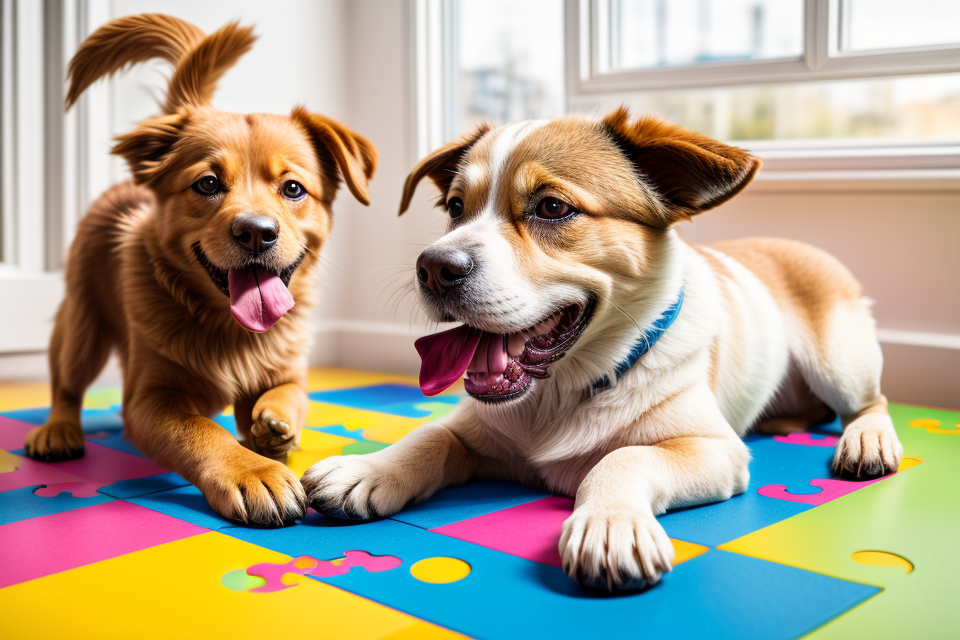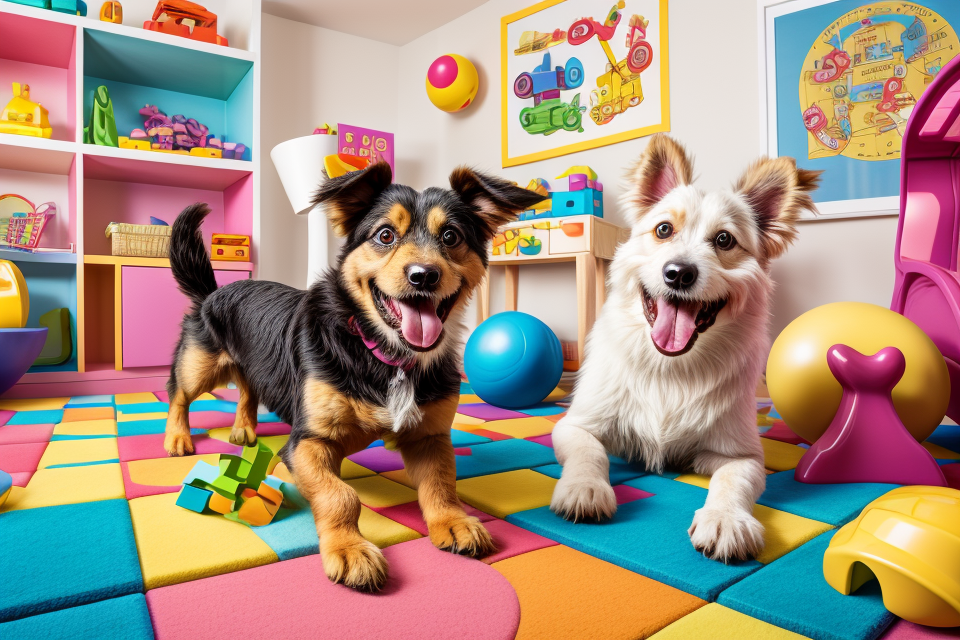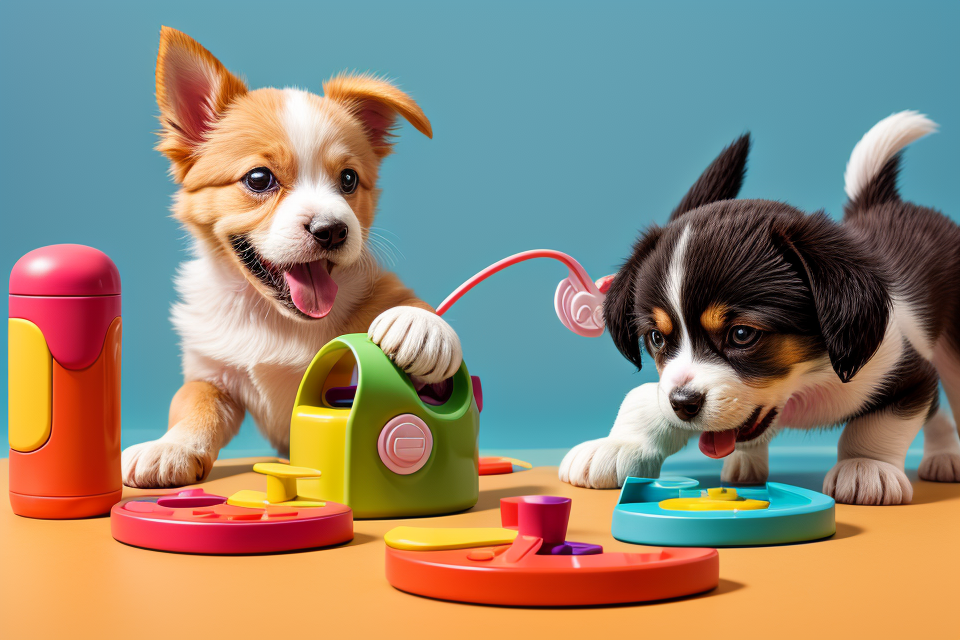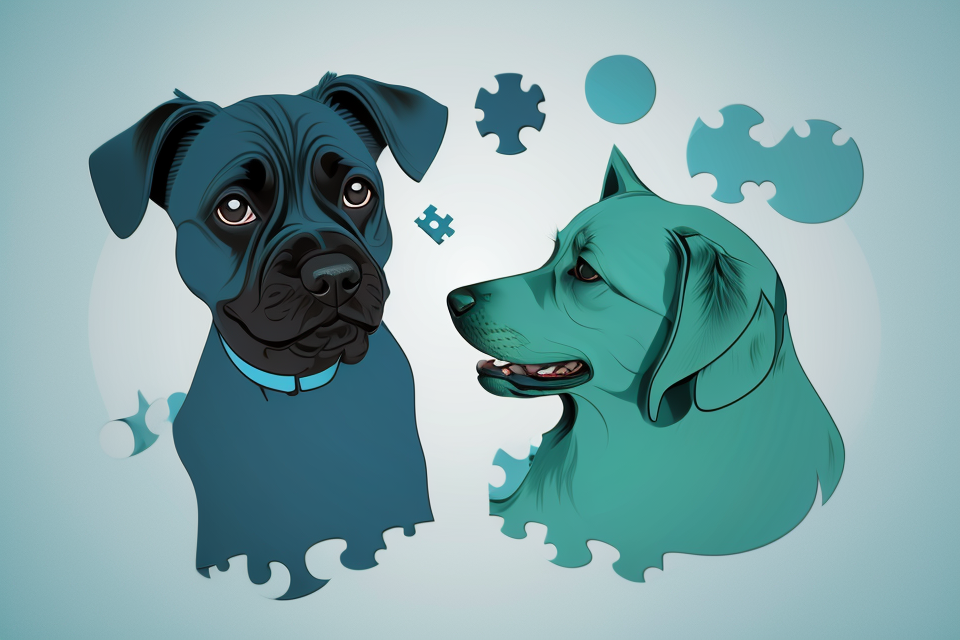Puzzle toys for dogs are specially designed to challenge and stimulate the cognitive abilities of our furry friends. These toys come in various shapes, sizes, and complexity levels, providing dogs with a fun and engaging way to exercise their minds. From interactive hide-and-seek games to intricate puzzles that require problem-solving skills, puzzle toys help keep dogs mentally sharp and provide hours of entertainment. Whether you’re looking to give your dog a new and exciting way to play or want to satisfy their natural instinct to use their brain, puzzle toys are the perfect solution. So, let’s dive into the world of canine cognition and discover how puzzle toys can help keep your furry companion’s mind active and engaged.
What are Puzzle Toys for Dogs?
Definition and Purpose
Puzzle toys for dogs are interactive games or toys designed to challenge a dog’s mental abilities and problem-solving skills. These toys typically require the dog to figure out how to access a hidden treat or toy by manipulating the toy in some way, such as by sliding, rotating, or pushing components to reveal the reward.
The purpose of puzzle toys for dogs is to provide mental stimulation and exercise for their brains, just like physical exercise is important for their bodies. Playing with puzzle toys can help prevent boredom, reduce destructive behavior, and keep dogs mentally sharp as they age. Puzzle toys can also help satisfy a dog’s natural instinct to hunt and solve problems, and can provide a fun and engaging way to interact with their owners.
Types of Puzzle Toys
Dogs are intelligent creatures, and it is important to keep their minds active to prevent boredom and behavioral problems. Puzzle toys are a great way to provide mental stimulation for dogs. There are several types of puzzle toys available for dogs, each designed to challenge their minds in different ways.
- Mental stimulation toys
Mental stimulation toys are designed to challenge a dog’s problem-solving skills. These toys may include hidden treats or food dispensing toys that require the dog to figure out how to get the reward. Some examples of mental stimulation toys include:
* The “food puzzle” toy, which requires the dog to figure out how to move the pieces to get the treat.- The “hide-and-seek” toy, which requires the dog to use its sense of smell to find the hidden treat.
- Interactive toys
Interactive toys are designed to encourage play and interaction between the dog and its owner. These toys may include puzzles that require the dog and owner to work together to solve a problem. Some examples of interactive toys include:- The “treat-dispensing” toy, which requires the dog and owner to work together to figure out how to get the treat.
- The “hide-and-seek” toy, which requires the dog and owner to take turns hiding treats for each other to find.
- Hide-and-seek toys
Hide-and-seek toys are designed to challenge a dog’s sense of smell and encourage foraging behavior. These toys may include puzzles that require the dog to find hidden treats or toys. Some examples of hide-and-seek toys include:- The “snuffle mat” toy, which is a mat filled with small pieces of food that the dog must sniff out.
- The “scent work” toy, which requires the dog to use its sense of smell to find hidden treats or toys.
- Food-dispensing toys
Food-dispensing toys are designed to provide a dog with a reward for solving a problem. These toys may include puzzles that require the dog to figure out how to get the food reward. Some examples of food-dispensing toys include:- The “treat-dispensing” toy, which requires the dog to figure out how to get the treat.
* The “food puzzle” toy, which requires the dog to figure out how to move the pieces to get the food reward.
- The “treat-dispensing” toy, which requires the dog to figure out how to get the treat.
Overall, puzzle toys are a great way to provide mental stimulation for dogs and keep their minds active. By choosing the right type of puzzle toy for your dog, you can help keep their mind sharp and prevent boredom and behavioral problems.
Selecting the Right Puzzle Toy for Your Dog
Factors to Consider
When selecting the right puzzle toy for your dog, there are several factors to consider. These factors will help you choose a toy that will challenge and stimulate your dog’s mind while providing hours of entertainment.
- Breed and size of the dog: Different breeds have different levels of intelligence and play styles. For example, smaller dogs like Terriers and Chihuahuas tend to be more active and require toys that are easier to manipulate. Larger dogs like Retrievers and Mastiffs may need toys that are more durable and challenging to manipulate.
- The dog’s age and health: Young puppies may not have the dexterity or coordination to play with complex puzzle toys. Older dogs may have health issues that make certain types of toys inappropriate. For example, a dog with arthritis may have difficulty manipulating a toy with small parts.
- The dog’s favorite activities and interests: Consider your dog’s natural instincts and preferences when selecting a puzzle toy. If your dog loves to dig, a toy that requires them to use their snout and paws to uncover hidden treats may be ideal. If your dog is a natural problem solver, a toy that requires them to figure out how to access hidden treats may be more suitable.
By taking these factors into account, you can choose a puzzle toy that will keep your dog’s brain active and engaged while providing them with hours of fun and mental stimulation.
Tips for Choosing the Best Puzzle Toy
Choosing the right puzzle toy for your dog is essential to keep their brain active and engaged. Here are some tips to help you make the right choice:
- Observe your dog’s behavior and preferences: Take note of your dog’s playing style and preferences. Do they prefer toys that they can carry around, or ones that they can play with alone? Are they more interested in toys that make noise or ones that they can chew on? By observing your dog’s behavior, you can determine the type of puzzle toy that will best suit their needs.
- Consider the difficulty level of the toy: Puzzle toys come in different levels of difficulty, and it’s important to choose one that will challenge your dog without frustrating them. If the toy is too easy, your dog may quickly lose interest. On the other hand, if it’s too difficult, they may become frustrated and stop playing altogether.
- Look for durable and safe materials: When choosing a puzzle toy, it’s important to consider the materials used. The toy should be made from durable materials that can withstand your dog’s playstyle. Additionally, it’s important to ensure that the toy is safe for your dog to chew on and play with. Look for toys that are made from non-toxic materials and do not contain any small parts that could be swallowed.
By considering these tips, you can choose the best puzzle toy for your dog and keep their brain active and engaged.
How to Introduce Puzzle Toys to Your Dog
Positive Reinforcement
- Use treats and praise to encourage your dog to play with the toy
- Offer small, high-value treats that your dog finds irresistible as an incentive to engage with the puzzle toy. This could include small pieces of cooked chicken, cheese, or other tasty rewards that your dog loves.
- Use verbal praise and physical affection (such as patting or rubbing) to reinforce positive behavior. When your dog successfully completes a challenge or interacts with the toy, shower them with praise and affection to strengthen the association between the puzzle toy and positive experiences.
- Reward your dog for successfully completing challenges
- Establish a clear set of rules or criteria for earning rewards. For example, you might reward your dog for pulling a specific lever or manipulating a certain element of the toy. This helps your dog understand what is expected of them and encourages them to persist in their efforts to solve the challenge.
- Use the reward system to gradually increase the difficulty of the challenges over time. As your dog becomes more skilled at solving the puzzle toy, you can gradually increase the complexity of the challenges to keep them engaged and mentally stimulated.
- Be consistent with the reward system to reinforce the positive association with the puzzle toy. Give rewards immediately after your dog completes a challenge, and always follow through on your promises to reinforce the connection between the toy and positive experiences.
Training Your Dog to Use Puzzle Toys
Setting Expectations
Training your dog to use puzzle toys can be a fun and engaging way to keep their mind active and stimulated. Here are some tips for setting expectations when introducing puzzle toys to your dog:
- Start with simple toys: Begin by introducing your dog to simple puzzle toys that are easy to figure out. This will help build their confidence and encourage them to continue trying new challenges.
- Use positive reinforcement: When your dog successfully solves the puzzle, reward them with treats or praise. This will encourage them to continue trying and will help them associate puzzle toys with positive experiences.
- Gradually increase difficulty: As your dog becomes more comfortable with puzzle toys, gradually increase the difficulty level of the toys you introduce. This will keep them engaged and challenged as they continue to learn and grow.
- Be patient: Training your dog to use puzzle toys may take time and patience. It’s important to remember that every dog is different and will learn at their own pace. Be patient and keep encouraging them to try.
Practice and Patience
When it comes to training your dog to use puzzle toys, practice and patience are key. Here are some tips to help you get started:
- Provide regular opportunities for your dog to use the toy:
- Start by introducing the puzzle toy to your dog in a quiet, low-distraction environment.
- Offer the toy in short, frequent sessions rather than one long session.
- Gradually increase the amount of time your dog spends with the toy.
- Be patient and persistent in training your dog:
- It’s important to remember that every dog is different and will learn at their own pace.
- Use positive reinforcement, such as treats and praise, to encourage your dog to interact with the toy.
- If your dog becomes frustrated or uninterested, take a break and try again later.
By providing regular opportunities for your dog to use the toy and being patient and persistent in training, you can help keep your canine brain active and engaged.
Enriching Your Dog’s Life with Puzzle Toys
Long-Term Benefits
Mental stimulation and exercise are crucial for your dog’s overall well-being. Puzzle toys can provide both of these benefits and more. By incorporating puzzle toys into your dog’s routine, you can:
- Maintain your dog’s mental acuity: Regular mental stimulation can help slow down cognitive decline in older dogs and prevent boredom-related behaviors in younger dogs. Puzzle toys can challenge your dog’s problem-solving skills and keep their mind sharp.
- Strengthen the bond between you and your dog: Playing with puzzle toys together can create a strong bond between you and your dog. It allows you to interact with your dog in a fun and engaging way, strengthening your relationship and creating lasting memories.
- Prevent destructive behaviors: When dogs are left alone and bored, they may engage in destructive behaviors such as chewing or digging. Puzzle toys can provide mental stimulation and keep your dog engaged, reducing the likelihood of these behaviors.
- Improve physical health: Some puzzle toys require your dog to move around or use specific body parts to access the treat, which can help improve their physical health and coordination.
Overall, incorporating puzzle toys into your dog’s routine can provide a range of long-term benefits that can improve their overall well-being and strengthen your bond with your furry friend.
Encouraging Creative Play
One of the most effective ways to keep your dog’s brain active is by encouraging creative play. Here are some tips to help you do just that:
- Encourage your dog to use their imagination and problem-solving skills:
- Provide a variety of puzzle toys that challenge your dog to think outside the box.
- Encourage your dog to explore different ways of solving the puzzle.
- Reward your dog for their efforts and progress.
- Provide a variety of puzzle toys to keep things interesting:
- Rotate your dog’s puzzle toys regularly to keep them engaged and interested.
- Offer a range of difficulty levels to challenge your dog as they become more skilled.
- Consider investing in interactive puzzle toys that provide both mental and physical stimulation.
By encouraging creative play with puzzle toys, you can help keep your dog’s mind active and engaged, while also strengthening the bond between you and your furry friend.
FAQs
1. What are puzzle toys for dogs?
Puzzle toys for dogs are interactive toys designed to challenge your dog’s mental abilities and keep their brain active. These toys often require your dog to figure out how to access hidden treats or toys by using problem-solving skills such as pushing, pulling, and manipulating the toy.
2. Why are puzzle toys important for dogs?
Puzzle toys are important for dogs because they provide mental stimulation, which is crucial for maintaining cognitive health and preventing boredom. Just like humans, dogs need mental stimulation to stay engaged and happy. Puzzle toys also help prevent destructive behaviors such as chewing and digging, which can occur when dogs are under-stimulated.
3. What types of puzzle toys are available for dogs?
There are many different types of puzzle toys available for dogs, including hide-and-seek toys, treat-dispensing toys, and interactive puzzles. Some toys require your dog to use their nose to find hidden treats, while others require them to use their paws or mouth to manipulate the toy. There are also interactive puzzles that require your dog to solve a series of challenges to receive a reward.
4. How do I choose the right puzzle toy for my dog?
When choosing a puzzle toy for your dog, consider their size, strength, and ability level. If your dog is small or elderly, you may want to choose a toy that is easy for them to manipulate. If your dog is large or strong, you may want to choose a toy that is durable and can withstand their play style. You should also consider your dog’s ability level and choose a toy that challenges them without being too difficult.
5. How often should I give my dog puzzle toys?
You should give your dog puzzle toys as often as possible, especially if they are prone to boredom or destructive behaviors. However, it’s important to monitor your dog’s playtime with puzzle toys to ensure they are not becoming too focused on the toy and neglecting other important activities such as exercise and socialization.



